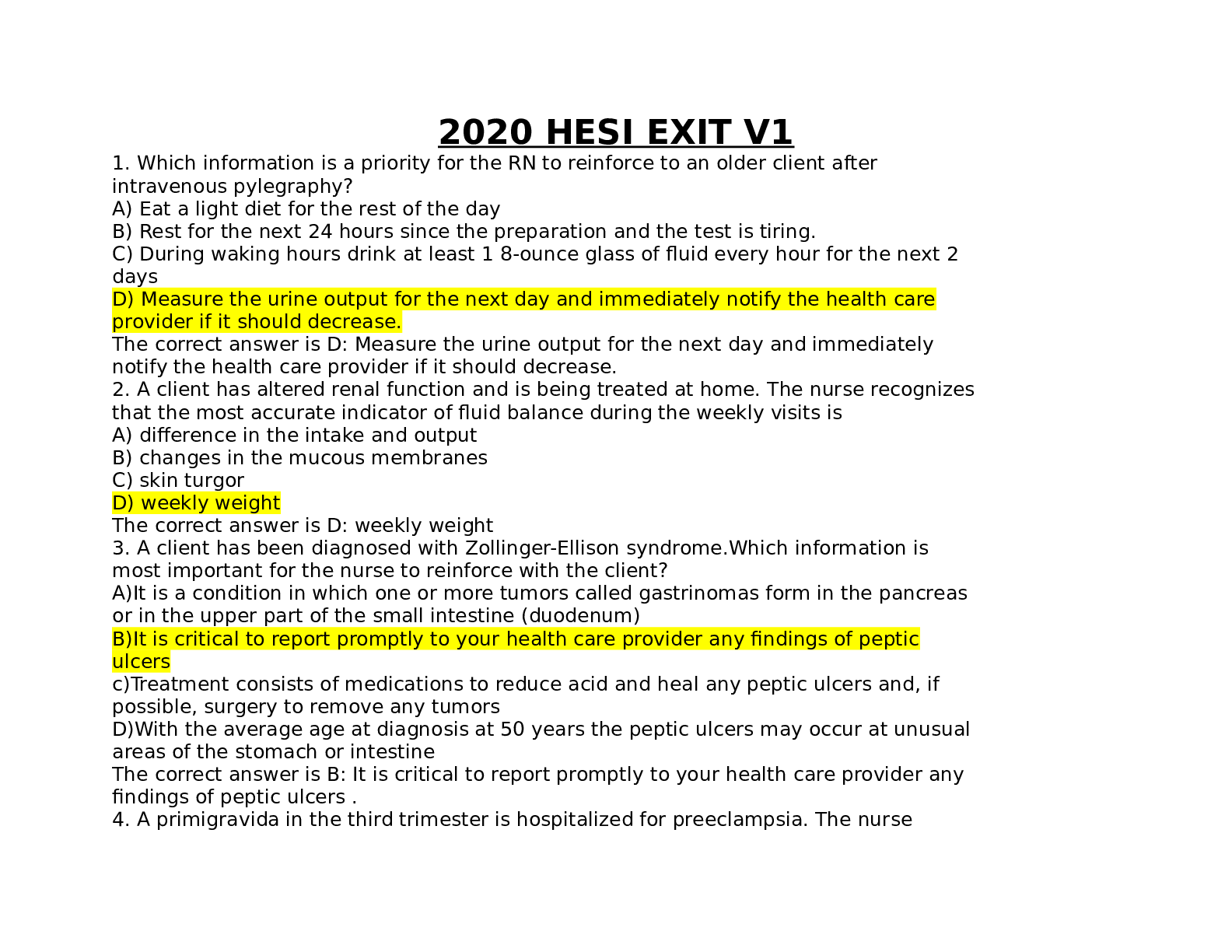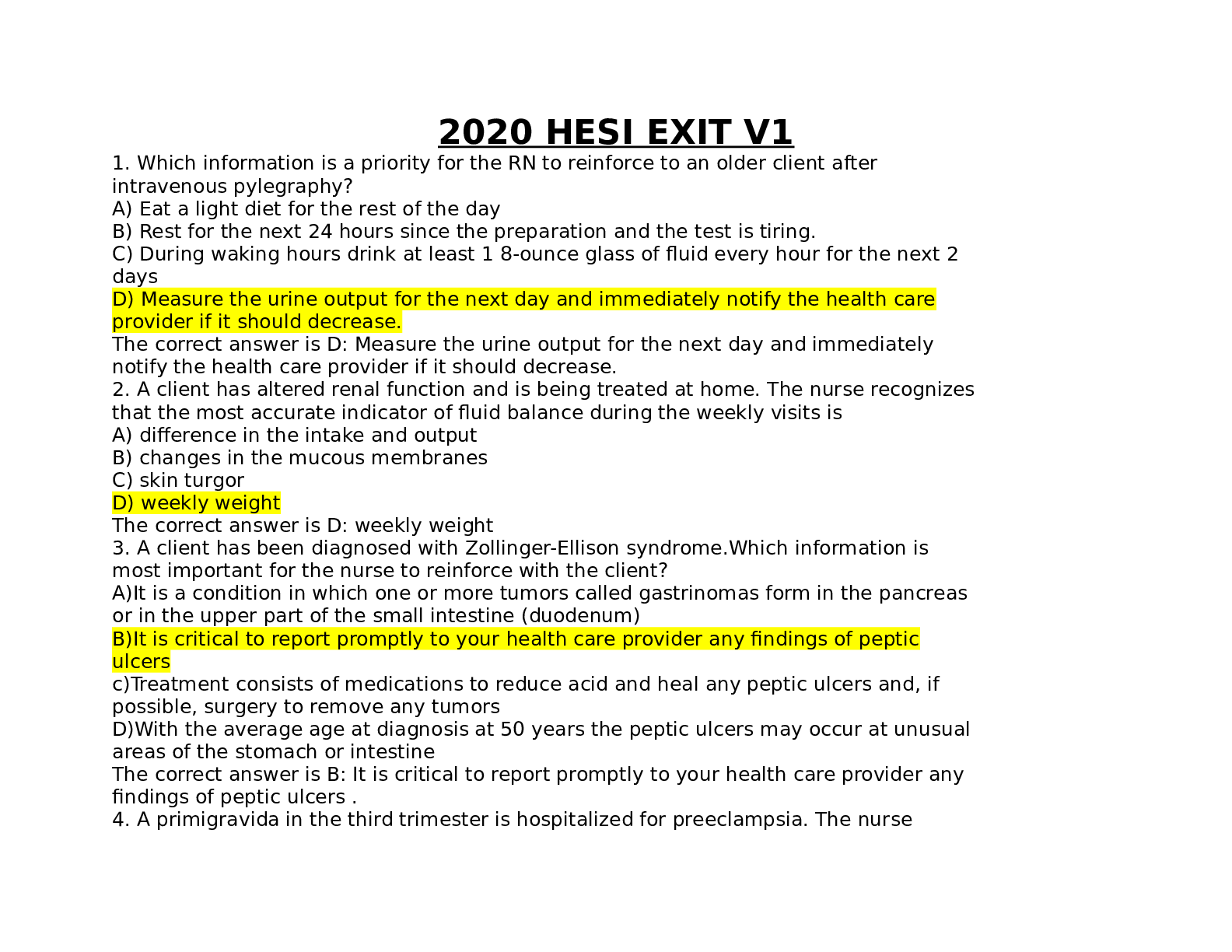1. Which information is a priority for the RN to reinforce to an older client after
intravenous pylegraphy?
A) Eat a light diet for the rest of the day
B) Rest for the next 24 hours since the preparation and the test is tiring.
C) During waking hours drink at least 1 8-ounce glass of fluid every hour for the next 2
days
D) Measure the urine output for the next day and immediately notify the health care
provider if it should decrease.
The correct answer is D: Measure the urine output for the next day and immediately
notify the health care provider if it should decrease.
2. A client has altered renal function and is being treated at home. The nurse recognizes
that the most accurate indicator of fluid balance during the weekly visits is
A) difference in the intake and output
B) changes in the mucous membranes
C) skin turgor
D) weekly weight
The correct answer is D: weekly weight
3. A client has been diagnosed with Zollinger-Ellison syndrome.Which information is
most important for the nurse to reinforce with the client?
A)It is a condition in which one or more tumors called gastrinomas form in the pancreas
or in the upper part of the small intestine (duodenum)
B)It is critical to report promptly to your health care provider any findings of peptic
ulcers
c)Treatment consists of medications to reduce acid and heal any peptic ulcers and, if
possible, surgery to remove any tumors
D)With the average age at diagnosis at 50 years the peptic ulcers may occur at unusual
areas of the stomach or intestine
The correct answer is B: It is critical to report promptly to your health care provider any
findings of peptic ulcers .
4. A primigravida in the third trimester is hospitalized for preeclampsia. The nurse
determines that the client’s blood pressure is increasing. Which action should the nurse
take first?
A) Check the protein level in urine
B) Have the client turn to the left side
C) Take the temperature
D) Monitor the urine output
The correct answer is B: Have the client turn to the left side
5. The nurse is caring for a client in atrial fibrillation. The atrial heart rate is 250 and the
ventricular rate is controlled at 75. Which of the following findings is cause for the most
concern?
A) Diminished bowel sounds
B) Loss of appetite
C) A cold, pale lower leg
D) Tachypnea
The correct answer is C: A cold, pale lower leg
6. The client with infective endocarditis must be assessed frequently by the home health
nurse. Which finding suggests that antibiotic therapy is not effective, and must be
reported by the nurse immediately to the healthcare provider?
A) Nausea and vomiting
B) Fever of 103 degrees Fahrenheit (39.5 degrees Celsius)
C) Diffuse macular rash
D) Muscle tenderness
The correct answer is B: Fever of 103 degrees F (39.5 degrees C)
7. A client who had a vasectomy is in the post recovery unit at an outpatient clinic. Which
of these points is most important to be reinforced by the nurse?
A) Until the health care provider has determined that your ejaculate doesn't contain
sperm, continue to use another form of contraception.
B)This procedure doesn't impede the production of male hormones or the production of
sperm in the testicles. The sperm can no longer enter your semen and no sperm are in
your ejaculate.
C) After your vasectomy, strenuous activity needs to be avoided for at least 48 hours. If
your work doesn't involve hard physical labor, you can return to your job as soon as you
feel up to it. The stitches
generally dissolve in seven to ten days.
D)The health care provider at this clinic recommends rest, ice, an athletic supporter or
over-the-counter pain medication to relieve any discomfort.
The correct answer is A: Until the health care provider has determined that your ejaculate
doesn't contain sperm, continue to use another form of contraception.
8. A client who is to have antineoplastic chemotherapy tells the nurses of a fear of being
sick all the time and wishes to try acupuncture. Which of these beliefs stated by the client
would be incorrect about acupuncture?
A)Some needles go as deep as 3 inches, depending on where they're placed in the body
and what the treatment is for. The needles usually are left in for 15 to 30 minutes.
B) In traditional Chinese medicine, imbalances in the basic energetic flow of life —
known as qi or chi — are thought to cause illness.
* C) The flow of life is believed to flow through major pathways or nerve clusters in your
body.
D) By inserting extremely fine needles into some of the over 400 acupuncture points in
various combinations it is believed that energy flow will rebalance to allow the body's
natural healing
mechanisms to take over.
The correct answer is C: The flow of life is believed to flow through major pathways or
nerve clusters in your body.
9. The nurse is discussing with a group of students the disease Kawasaki. What statement
made by a student about Kawasaki disease is incorrect?
A)It also called mucocutaneous lymph node syndrome because it affects the mucous
membranes (inside the mouth, throat and nose), skin and lymph nodes.
B)In the second phase of the disease, findings include peeling of the skin on the hands
and feet with joint and abdominal pain
C)Kawasaki disease occurs most often in boys, children younger than age 5 and children
of Hispanic descent
D)Initially findings are a sudden high fever, usually above 104 degrees Fahrenheit, which
lasts 1 to2 weeks
The correct answer is C: Kawasaki disease occurs most often in boys, children younger
than age 5 and children of Hispanic descent
10. A client has viral pneumonia affecting 2/3 of the right lung. What would be the best
position to teach the client to lie in every other hour during first 12 hours after admission?
A) Side-lying on the left with the head elevated 10 degrees
B) Side-lying on the left with the head elevated 35 degrees
C) Side-lying on the right wil the head elevated 10 degrees
D) Side-lying on the right with the head elevated 35 degrees
The correct answer is A: Side-lying on the left with the head elevated 10 degrees
11. A client has an indwelling catheter with continuous bladder irrigation after
undergoing a transurethral resection of the prostate (TURP) 12 hours ago. Which finding
at this time should be reported to the health care provider?
A) Light, pink urine
B) occasional suprapubic cramping
C) minimal drainage into the urinary collection bag
D) complaints of the feeling of pulling on the urinary catheter The correct answer is C:
minimal drainage into the urinary collection bag
12. A nurse is performing CPR on an adult who went into cardiopulmonary arrest.
Another nurse enters the room in response to the call. After checking the client’s pulse
and respirations, what should
be the function of the second nurse?
A) Relieve the nurse performing CPR
B) Go get the code cart
C) Participate with the compressions or breathing
D) Validate the client's advanced directive
The correct answer is C: Participate with the compressions or breathing
13. The nurse assesses a 72 year-old client who was admitted for right sided congestive
heart failure. Which of the following would the nurse anticipate finding?
A) Decreased urinary output
B) Jugular vein distention
C) Pleural effusion
D) Bibasilar crackles
The correct answer is B: Jugular vein distention
Read More


